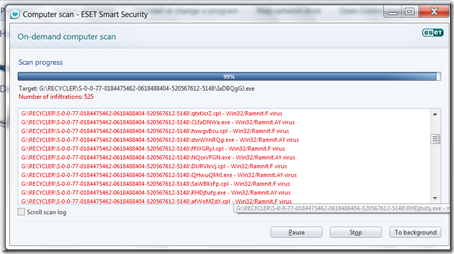Wednesday, November 30, 2016
The Win32 Ramnit Virus Detection and Removal
The Win32 Ramnit Virus Detection and Removal
Win32/Ramnit is a file infector detected in July 2010. It is also a virus in the same family as Virut, Sality and virtob. It attacks Windows XP, Windows Vista, Windows 7 executable files, it infects those with the extensions .exe, .dll and .html and it can also be distributed via external removable drives such as fllash disk, etc
.
When executed, the virus copies itself in some of the the following locations
The following Registry entries are set:
The virus creates and runs a new thread with its own program code within the following processes:
The host file is modified in a way that causes the virus to be executed prior to running the original code. The size of the inserted code is 53 KB .
The Windows Shell allows local users or remote attackers to execute arbitrary code via a crafted *.lnk, *.pif shortcut file when its icon is displayed.
No further user interaction is required to execute arbitrary code.

The virus acquires data and commands from a remote computer or the Internet.
The virus contains a list of addresses.
It can execute the following operations:
The virus may create the following files:
The virus connects to the following addresses:
The virus may create and run a new thread with its own program code within any running process.
After the Win32 Ramnit worm virus removed. Follow the steps below to completely restore your external drive way back before the problem occured.
.

Other Virus Aliases
W32/Infector.Gen2 (Avira)- Win32/Ramnit.A (CA) Win32/Ramnit.AY (ESET),Win32/Ramnit.F (Eset),Win32.Rmnet (Dr.Web), W32.Infector (Ikarus), W32/Ramnit.a (McAfee), W32/Patched-I (Sophos), PE_RAMNIT.A (Trend Micro),Type_Win32 (Kaspersky), Win32/Zbot.A (AVG)
Virus execution
- %programfiles%MicrosoftWaterMark.exe
- %commonprogramfiles%MicrosoftWaterMark.exe
- %appdata%MicrosoftWaterMark.exe
- %system%MicrosoftWaterMark.exe
- %windir%MicrosoftWaterMark.exe
- %temp%MicrosoftWaterMark.exe
- %homedrive%%homepath%MicrosoftWaterMark.exe
The following Registry entries are set:
- [HKEY_LOCAL_MACHINESoftwareMicrosoftWindows NTCurrentVersionWinlogon]
- "Userinit" = "%originalvalue%, %malwarefolder%MicrosoftWaterMark.exe"
This causes the virus to be executed on every system start.
The virus creates and runs a new thread with its own program code within the following processes:
- Svchost.exe
- Executable file infection
- The virus searches local drives for files with the following file extensions:
- .exe
- .dll
- RMNetwork
- Files are infected by adding a new section that contains the virus .
The host file is modified in a way that causes the virus to be executed prior to running the original code. The size of the inserted code is 53 KB .
Virus File infection
- The virus searches local drives for files with the following file extensions:
- .htm
- .html
The Windows Shell allows local users or remote attackers to execute arbitrary code via a crafted *.lnk, *.pif shortcut file when its icon is displayed.
No further user interaction is required to execute arbitrary code.
The virus creates the following files:

- %removabledrive%RECYCLERS-7-1-36-6133081425-6700277004-675130086-4217%variable1%.exe
- %removabledrive%RECYCLERS-7-1-36-6133081425-6700277004-675130086-4217%variable2%.cpl
- %removabledrive%autorun.inf
- %removabledrive%Copy of Shortcut to (1).lnk
- %removabledrive%Copy of Shortcut to (2).lnk
- %removabledrive%Copy of Shortcut to (3).lnk
- %removabledrive%Copy of Shortcut to (4).lnk
The virus acquires data and commands from a remote computer or the Internet.
The virus contains a list of addresses.
It can execute the following operations:
- capture screenshots
- send gathered information
- download files from a remote computer and/or the Internet
- run executable files
- shut down/restart the computer
The virus may create the following files:
- %system%dmlconf.dat
The virus connects to the following addresses:
- google.com
- bing.com
- yahoo.com
The virus may create and run a new thread with its own program code within any running process.
The Virus Removal
To fix the issue:- update the anti-virus into it’s latest signature
- Then run a quick scan in your computer
- Run infected external storage
After the Win32 Ramnit worm virus removed. Follow the steps below to completely restore your external drive way back before the problem occured.
- Open the external drive
- Delete all files except the drive icon that have no drive letter
- Open the drive icon with no drive letter
- Select all your files and cut or copy
- Then go back to my computer
- Open external storage device (that is, flash drive, usb drive, external hard disk or whatever it is)
- Paste your file
- Then, delete the “the drive icon that have no drive letter”
Before you proceed make sure the following Folder Options Menu are selected:
- Select Show hidden files, folders, or drives
- Uncheck Hide extensions for known file types
- Unchecked Hide protected operating files (recommended)
Available link for download